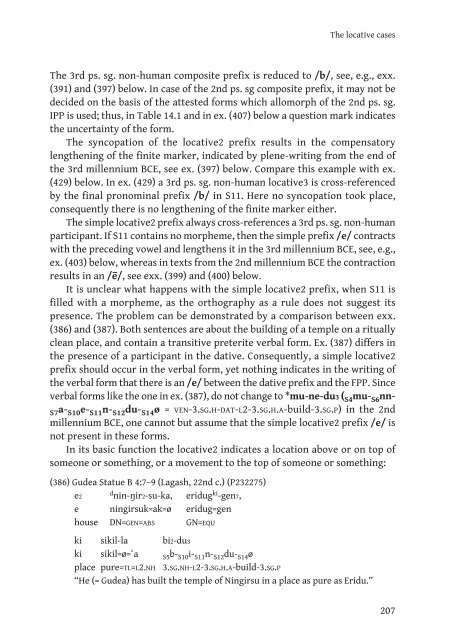SUMERIAN
Zolyomi_Sumer_READER
Zolyomi_Sumer_READER
Create successful ePaper yourself
Turn your PDF publications into a flip-book with our unique Google optimized e-Paper software.
The locative cases<br />
The 3rd ps. sg. non-human composite prefix is reduced to /b/, see, e.g., exx.<br />
(391) and (397) below. In case of the 2nd ps. sg composite prefix, it may not be<br />
decided on the basis of the attested forms which allomorph of the 2nd ps. sg.<br />
IPP is used; thus, in Table 14.1 and in ex. (407) below a question mark indicates<br />
the uncertainty of the form.<br />
The syncopation of the locative2 prefix results in the compensatory<br />
lengthening of the finite marker, indicated by plene-writing from the end of<br />
the 3rd millennium BCE, see ex. (397) below. Compare this example with ex.<br />
(429) below. In ex. (429) a 3rd ps. sg. non-human locative3 is cross-referenced<br />
by the final pronominal prefix /b/ in S11. Here no syncopation took place,<br />
consequently there is no lengthening of the finite marker either.<br />
The simple locative2 prefix always cross-references a 3rd ps. sg. non-human<br />
participant. If S11 contains no morpheme, then the simple prefix /e/ contracts<br />
with the preceding vowel and lengthens it in the 3rd millennium BCE, see, e.g.,<br />
ex. (403) below, whereas in texts from the 2nd millennium BCE the contraction<br />
results in an /ē/, see exx. (399) and (400) below.<br />
It is unclear what happens with the simple locative2 prefix, when S11 is<br />
filled with a morpheme, as the orthography as a rule does not suggest its<br />
presence. The problem can be demonstrated by a comparison between exx.<br />
(386) and (387). Both sentences are about the building of a temple on a ritually<br />
clean place, and contain a transitive preterite verbal form. Ex. (387) differs in<br />
the presence of a participant in the dative. Consequently, a simple locative2<br />
prefix should occur in the verbal form, yet nothing indicates in the writing of<br />
the verbal form that there is an /e/ between the dative prefix and the FPP. Since<br />
verbal forms like the one in ex. (387), do not change to *mu-ne-du₃ ( S4 mu- S6 nn-<br />
S7 a- S10 e- S11 n- S12 du- S14ø = VEN-3.SG.H-DAT-L2-3.SG.H.A-build-3.SG.P) in the 2nd<br />
millennium BCE, one cannot but assume that the simple locative2 prefix /e/ is<br />
not present in these forms.<br />
In its basic function the locative2 indicates a location above or on top of<br />
someone or something, or a movement to the top of someone or something:<br />
(386) Gudea Statue B 4:7–9 (Lagash, 22nd c.) (P232275)<br />
e₂ d nin-ŋir₂-su-ka, eridug ki -gen₇,<br />
e ningirsuk=ak=ø eridug=gen<br />
house DN=GEN=ABS GN=EQU<br />
ki sikil-la bi₂-du₃<br />
ki sikil=ø=ʾa S5 b- S10 i- S11 n- S12 du- S14 ø<br />
place pure=TL=L2.NH 3.SG.NH-L2-3.SG.H.A-build-3.SG.P<br />
“He (= Gudea) has built the temple of Ningirsu in a place as pure as Eridu.”<br />
207


